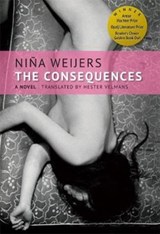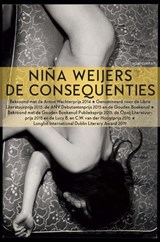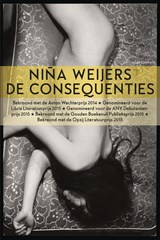On translating the first lines of Niña Weijers' De consequenties (The Consequences), by Hester Velmans
06 november 2017Hester Velmans vertaalde Niña Weijers' De consequenties als The Consequences. We vroegen haar haar werk toe te lichten. Over het uitleggen van water-based cultural assumptions.
Op de dag dat Minnie Panis voor de derde keer uit haar eigen leven verdween stond de zon laag en de maan hoog aan de hemel.
The day Minnie Panis vanished from her own life for the third time, the sun was low in the sky and the moon was high.
The first sentence of Niña Weijers’ The Consequences has all the hallmarks of a page-turner: what we have here is a mystery, a young woman who seems to be in the habit of disappearing from her own life. It’s a wonderful opening sentence, immediately intriguing and exciting, yet somehow soothing in its poetic, almost biblical cadence.
No modest ambitions
When we met, I asked Niña whether it was her intention to give her very literary, philosophical book the aura of a mystery novel. She replied that what she set out to do was to get away from the tendency to pigeonhole books and assign them to a certain genre. She said she wanted to break out of publishing’s conventional boundaries, the expectation that you should write short sentences, ‘write what you know’, and, above all, be modest in your ambitions, especially if you’re young and it’s your first novel.
Niña Weijers has written a novel that is more ambitious and outward-looking than much of the Dutch fiction I have read. It deals in big themes; in particular, the question of existence - existentialism portrayed as an artistic concept. Minnie Panis, the heroine, is an artist who uses her own life as a starting point for her conceptual works, which are all about the negative spaces in her life - the garbage she tosses out (the piece is called ‘Does Minnie Panis Exist?’) or the belongings she sells or gives away (‘Nothing Personal’). It’s about the possibility or impossibility of disappearing from one’s life.
A water-based culture
The challenge for the translator is to move the words, concepts and themes of the novel into another language while not losing the cultural nuances. It’s a challenge that confronted me in the very first paragraph, which goes on to describe a particularly Dutch phenomenon: the obsession with whether the winter will be cold enough to support skating on the canals, an increasingly rare event today.
Dagen achtereen had het stevig gevroren. De sluizen in de binnenstad van Amsterdam waren gesloten en voor het eerst in jaren werd er geschaatst op de grachten. Er werden tochten georganiseerd en afgelast, er werd gespeculeerd over een Elfstedentocht, wel, niet, een winterse cadans die het land in zijn greep hield alsof het koersen betrof en iedereen aandelen bezat. Toen nam de vorst af. De lucht werd grijs en vochtig, en ze leek niet zachter maar harder en leger. Gelige ijsschotsen staken uit de Herengracht, blikjes bier en chips verpakkingen kwamen bovendrijven en het was alsof iedereen nu pas de kou begon te voelen, en de zwaarte van de winter.
For several days in a row there had been a hard freeze. The sluices of Amsterdam’s inner city were closed, and for the first time in years there was skating on the canals. Long-distance skating tours were organized and called off, people speculated there might even be an Elfstedentocht, the famous Eleven-Cities marathon, yes, and then again no; a winter’s dance keeping the country on its toes, like the gyrations of a stock market in which everyone owned shares. Then, abruptly, the freeze was over. The sky grew grey and moist, appearing not gentler, but harder, emptier. Yellow ice floes canted up out of the Herengracht, beer cans and empty chips bags came bobbing up to the surface, and it was as if everyone had only just begun to be aware of the cold, and the weight of winter.
Since I felt it was necessary to explain what the Elfstedentocht was, I added the two phrases ‘long-distance skating tours’ and ‘famous Eleven-Cities marathon’. But I could not even begin to give the underlying context, which is that Holland is a thoroughly watery country, much of it below sea level, and that consequently, skating and swimming are intrinsic to the Dutch way of life. The water is both a source of great fun and a lethal threat. (The passage above ends with Minnie silently falling through the ice.)
Another example of water-based cultural assumptions is that as a child, Minnie proudly displays a number of ‘swimming diplomas’ above her bed. The reader may not know that in the Netherlands it is compulsory for children to learn to swim. To pass your ‘A’ diploma you have to be able to jump into the pool fully clothed; for the more advanced ‘C’ diploma, children have to swim a length underwater and come up in a hole in a simulated ‘ice sheet’.
The question that always flummoxes me when I’m translating is: is it my responsibility to explain such aspects of the culture, or should I leave it for the reader to work out for himself, even if he may miss some of the book’s layers of meaning? There are many other levels on which the reader can enjoy this book, of course, so perhaps it doesn’t matter. The truth is that a translation can never give you the multilayered complexity of the original. Which, in a way, also enhances the mystery… and that isn’t such a bad thing either.
Hester Velmans vertaling van Een hart van steen van Renate Dorrestein werd bekroond met de Vondelprijs in 2001. In 2014 kreeg zij een NEA (U.S. National Endowment of the Arts) Translation Fellowship. Vorig jaar verschenen haar vertalingen van Daglicht van Marion Pauw, van The Secret Diary of Hendrik Groen, 83 ¼ Years Old van Hendrik Groen [toelichting] en Joost Zwagermans 'Winnie en de onschuld' in The Penguin Book of Short Stories (2016). Ga voor meer informatie over Hester Velmans naar Hestervelmans.com.






